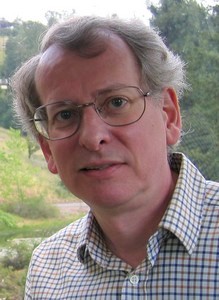I’m Mike Cowlishaw, a Fellow of the Royal Academy of Engineering, a Visiting Professor at the Department of Computer Science at the University of Warwick, and Editor of the IEEE 754 (ISO/IEC 60559:2011) standard. I am a retired IBM Fellow [1].
| e-mail: | mfc@speleotrove.com |
| Websites: | speleotrove.com and speleogroup.org |
| Facebook: | Mike Cowlishaw |
My technical interests include:
- Panoramas. My most recent programming project (available since
September 2018) is
PanGazer, a program for viewing
images and panoramas, including 360° spherical and hemispherical
panoramas as captured by drones.
- Mapping and cave surveying. I am also continuing to enhance
MapGazer, an application I
wrote for bringing together and overlaying maps, routes, walking
and bicycling tracks, cave surveys, speleological sites, and other
places of interest.
- Decimal arithmetic
(algorism)
in hardware and software, including
– the decimal data types and arithmetic in the IEEE 754 and ISO/IEC/IEEE 60559:2011 standards (of which I am the Editor)
– the Decimal FAQ (Frequently Asked Questions) webpage
– the General Decimal Arithmetic Specification
– the decNumber open source implementation of this in ANSI C
– the enhanced BigDecimal class for Java 5 (see Java SR-13).
- Technologies for use in caving with Speleogroup,
including drones (I fly a Mavic Pro) for investigating hard-to-get-to
speleological sites;
high-power Light-Emitting Diodes (LEDs) and designing efficient circuits for driving them and testing them; cave surveying
equipment and technologies (dead reckoning and surface GPS,
etc.); and bat detectors.
- Photography, including underground, drone, and 3D photography.
A few of my stereo and panoramic photographs can be
found in my gallery. I now only
use cameras with viewfinders, and much prefer the small and lightweight
(currently Panasonic TZ100, GM5, and GX7/80).
- Lightweight aircraft (microlights and ultralights); I hold a National Private Pilots Licence (Microlight), and until recently owned and
flew a single-seater flexwing aircraft (a Flylight MotorFloater). In 2012 I developed a simulation model of it for FSX.
- Weather research, particularly into wind gusts, their likelihood,
and their relevance to light aircraft.
- Vision and colour perception (hence the colour highlighting in
LEXX and MapGazer, the interpolation and geometry used in PanGazer, and the shading algorithms used in PMGlobe and Palm Globe).
- Bicycling science (in 2013 I took up regular cycling again, after
a 40-year gap); I pedal a Charge Mixer with 11-speed hub gear.
- Tollos – a supervisor program
for ARM Cortex microcontrollers which I developed as a base for my
experimental avionics and low-power
caving aids; it is written entirely in C and you can run it on the
mbed
and also many other devices, such as those from STM.
- Electronic publishing, including the Oxford English Dictionary (for which I wrote the LEXX (now called LPEX)
editor and separately am a consultant), the IBM Jargon Dictionary, SGML, Wikipedia, the World Wide Web, and my GoServe Web server (the first
HTTP 1.0-compliant web server, used for my research tool, MemoWiki).
- The Rexx, Object Rexx, NetRexx,
Java, PL/I, and C programming languages
(I created Rexx and NetRexx).
- Lightweight (preferably solid-state) computers (one such is the
IBM Workpad, for which
I wrote Palm Globe; another is
the Acorn System 1 and the Emulator I wrote for that); I currently carry an Asus T100T ‘transformer’
pad/notebook. Before that, I used an Asus Eee PC 900 netbook (to
which I added a fast SATA 32GB solid-state drive) for 7 years. Since
2012 I have been experimenting with Android devices (programming
the Nexus 7 and various Android ’phones). My current favourite
is the Sony Xperia Active, which doubled as an excellent bicycle
computer, however I’ve had to replace that with a Sony Xperia Z3
Compact because Google kept ‘bricking’ the Active by installing apps
that filled its memory ...
- PMGlobe; a programmable World
Globe that lets you see the world from afar, either from a fixed
viewpoint or turning with the sun (you can add your own places of
interest, measure distance, use macros, etc.); this predates Google
Earth by a decade or two – it was originally written for OS/2.
- Cognitive processes, including neural, genetic, and evolutionary
algorithms and systems, especially empirical models that may give
insight into thought processes.
Legend: FREng — Fellow of the Royal Academy of Engineering; BSc — Bachelor of Science; CEng — Chartered Engineer; FIET — Fellow of the Institute of Engineering and Technology (was IEE); FBCS — Fellow of the British Computer Society; CITP — Chartered Information Technology Professional. Java is a trademark of Sun Microsystems Inc.
[1] The IBM Fellow programme began in 1962/3; I was the 113th IBM Fellow appointed, in June 1990. I took early retirement from IBM in March 2010; as of that date there had been 217 IBM Fellows appointed. In IBM there were/are typically about 55 active Fellows out of around 400,000 employees.
The pages and data here are for non-commercial use only. All text content © Mike Cowlishaw, 2009, 2018, except where marked otherwise. All rights reserved. Please see http://speleotrove.com/mfc/ for contact details.
Privacy policy: the Speleotrove website records no personal information and sets no ‘cookies’. However, statistics, etc. might be recorded by the web hosting service.
This page was last edited on 2019-01-04 by mfc.
